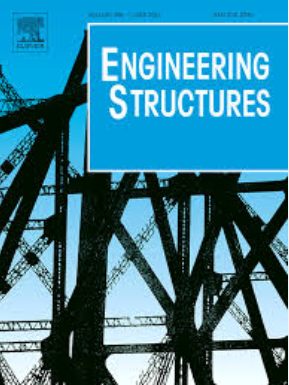Seismic performance of precast double-column rocking piers with U-shaped tendons and stiffening steel shoes: Experimental and numerical study
IF 5.6
1区 工程技术
Q1 ENGINEERING, CIVIL
引用次数: 0
Abstract
Rocking piers exhibit promising seismic resistance and are suitable for precast bridges. However, their application to engineering practice, especially the widely used double-column piers, is hindered by the difficulty in operating prestressed tendons, protecting rocking toes, and achieving a satisfactory design. Hence, this study proposes novel fully-arranged U-shaped tendons, partially-arranged U-shaped tendons, and stiffening steel shoes for precast double-column rocking piers to improve the seismic performance and facilitate the construction and maintenance. Cyclic tests were conducted on two scaled specimens, both employing steel shoes, with one specimen equipped with a fully-arranged U-shaped tendon and the other with straight tendons and partially-arranged U-shaped tendons. Then, numerical models were established and validated. Finally, a comparative study was performed to investigate the influences of the U-shaped tendons and steel shoes on the pier performance. The test results show that both specimens behaved as typical low-damage rocking piers and ultimately failed due to extensive fractures of the steel shoes. The comparative study illustrates that the steel shoes can significantly protect the rocking toes, and that the fully-arranged U-shaped tendons can replace the ordinary straight tendons, while the partially-arranged ones can effectively enhance the longitudinal pier capacity without excessively impairing the transverse performance.
求助全文
约1分钟内获得全文
求助全文
来源期刊

Engineering Structures
工程技术-工程:土木
CiteScore
10.20
自引率
14.50%
发文量
1385
审稿时长
67 days
期刊介绍:
Engineering Structures provides a forum for a broad blend of scientific and technical papers to reflect the evolving needs of the structural engineering and structural mechanics communities. Particularly welcome are contributions dealing with applications of structural engineering and mechanics principles in all areas of technology. The journal aspires to a broad and integrated coverage of the effects of dynamic loadings and of the modelling techniques whereby the structural response to these loadings may be computed.
The scope of Engineering Structures encompasses, but is not restricted to, the following areas: infrastructure engineering; earthquake engineering; structure-fluid-soil interaction; wind engineering; fire engineering; blast engineering; structural reliability/stability; life assessment/integrity; structural health monitoring; multi-hazard engineering; structural dynamics; optimization; expert systems; experimental modelling; performance-based design; multiscale analysis; value engineering.
Topics of interest include: tall buildings; innovative structures; environmentally responsive structures; bridges; stadiums; commercial and public buildings; transmission towers; television and telecommunication masts; foldable structures; cooling towers; plates and shells; suspension structures; protective structures; smart structures; nuclear reactors; dams; pressure vessels; pipelines; tunnels.
Engineering Structures also publishes review articles, short communications and discussions, book reviews, and a diary on international events related to any aspect of structural engineering.
 求助内容:
求助内容: 应助结果提醒方式:
应助结果提醒方式:


